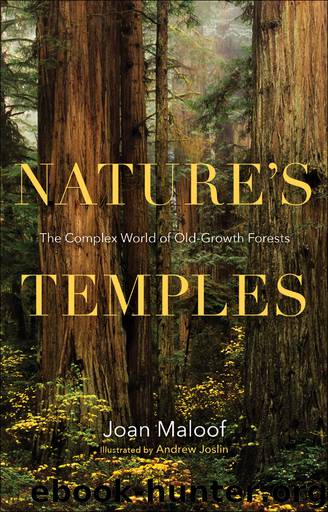Nature's Temples by Joan Maloof

Author:Joan Maloof
Language: eng
Format: epub
Publisher: Timber Press
Published: 2016-11-22T16:00:00+00:00
Hobblebush (Viburnum alnifolium), another woody plant species found in old growth
Wild sarsaparilla (Auralia nudicaulis), a plant often found in old growth
There is more to share about herbaceous plants in the forest. Julie Wyatt and Miles Silman followed up on Meier’s work, adding much fancier statistical analyses but comparing just three old-growth and three mature forests in the Southeast instead of the nine that Meier had studied. Their results confirm what he found: “Current forestry management is not conducive to long-term maintenance of herb diversity.”
If you feel moved to wander your favorite woodland and look for some of the herbaceous plants they found associated with old growth, here are three to get you started: spotted geranium (Geranium maculatum), northern maidenhair fern (Adiantum pedatum), and sweet white violet (Viola blanda). Notably, maidenhair fern and another round-leaf violet were found only in the old-growth forests in the D’Amato study too. Again, these are not at all rare species, but there is something about forest disturbance and regrowth that they, or their symbiotic partners, do not like.
Since so little true old-growth forest is left and we are starting to recognize its importance, a type of specialized forest management has recently been developed for the purpose of creating or hastening old-growth attributes in older second-growth forests. Picture a person with a chain saw felling a tree, or a few, to create a gap in the canopy of the type that would exist in old growth. The tree is left lying on the forest floor to decompose, thus adding large coarse woody debris to the ecosystem. Other trees are girdled to create standing deadwood (snags) or hacked at to create cavities for wildlife. A shovel might be used to create pit-and-mound topography. All these things would happen on their own, of course—given another hundred years or so. In its purest form this sort of management would likely increase the diversity and cover of herbaceous plants on the forest floor, and it could increase animal habitat as well. But it could also increase the likelihood of invasive plants and worms (through seeds and eggs carried on workers’ boots), which would then decrease the numbers of native herbaceous plants. There is no right answer here, but some tend toward less management and some tend toward more. I am one of those who tend toward less, as I have seen what more can do.
When we walk through the oldest forest near our town—most likely an 80-something-year-old forest—we may be enthralled by the woodland vegetation and the towering trees without ever realizing what we are missing. We see clear-cut forests that seem to be recovering in our lifetimes and we may start believing that all is well. And some research shows this too. But a closer look at that particular research shows that often the forest used for baseline comparison is only 100 to 150 years old. So little old-growth forest remains in the eastern United States that researchers don’t even have good study plots to choose from. One result is that our baselines are shifting.
Download
This site does not store any files on its server. We only index and link to content provided by other sites. Please contact the content providers to delete copyright contents if any and email us, we'll remove relevant links or contents immediately.
| Fisheries & Aquaculture | Forests & Forestry |
The Lonely City by Olivia Laing(4746)
Animal Frequency by Melissa Alvarez(4394)
All Creatures Great and Small by James Herriot(4230)
Walking by Henry David Thoreau(3892)
Exit West by Mohsin Hamid(3776)
Origin Story: A Big History of Everything by David Christian(3648)
COSMOS by Carl Sagan(3553)
How to Read Water: Clues and Patterns from Puddles to the Sea (Natural Navigation) by Tristan Gooley(3406)
Hedgerow by John Wright(3274)
The Inner Life of Animals by Peter Wohlleben(3259)
How to Read Nature by Tristan Gooley(3249)
How to Do Nothing by Jenny Odell(3232)
Project Animal Farm: An Accidental Journey into the Secret World of Farming and the Truth About Our Food by Sonia Faruqi(3176)
Origin Story by David Christian(3145)
Water by Ian Miller(3126)
A Forest Journey by John Perlin(3026)
The Plant Messiah by Carlos Magdalena(2881)
A Wilder Time by William E. Glassley(2817)
Forests: A Very Short Introduction by Jaboury Ghazoul(2790)
